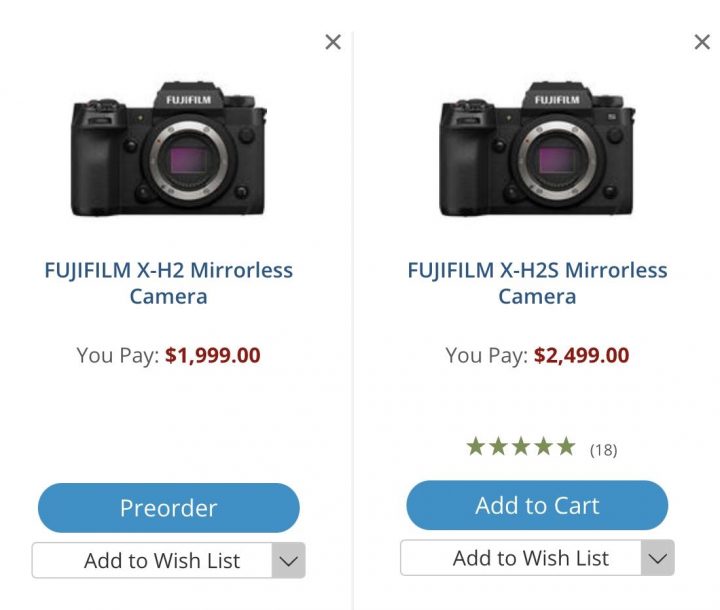Cameralabs Fujifilm X-H2 Review for Stills (vs X-H2s)
Gordon from Cameralabs posted his photography centric review of the Fujifilm X-H2.
The full video can be seen below, as well as a summary.
- Fujifilm X-H2: BHphoto / AmazonUS / Adorama / Moment / Focuscamera
- Fujifilm X-H2S: BHphoto / AmazonUS / Adorama / Moment
- XF 56mm f/1.2 R WR: BHphoto / AmazonUS / Adorama / Moment / Focuscamera
- in his experience, the latest XF prime lenses show the best results in terms of resolution if combined with the new 40MP sensor
- X-H2 records visibly finer details over the X-H2s
- X-H2 has pixel shift, the X-H2s has not
- pixel shift gives noticeably sharper images over native 40MP images
ISO Noise
- X-H2 has base ISO 125
- JPEG
- the X-H2 files remain pretty clean until ISO800 and begin to reveal some noise at ISO1600
- but since the artifacts are smaller thanks to the higher resolution files, it does remain fairly well hidden
- at ISO3200 something changes with what looks like increased noise reduction with noticeably softer image results
- the 26MP X-H2s jpeg files took a small lead at very high ISO, but not enough to persuade him to chose the X-H2s over X-H2 based on noise alone
- RAW
- at the same ISO value, the X-H2s files are slightly darker
- noise speckle appear much sooner than with the JPEGs (noise reduction was completely turned off)
- in normal use you’ll not see that noise, as he processed them aggressively to reveal the noise and the difference in noise between X-H2 and X-H2s
- while the X-H2 files look visibly noisier than the X-H2S at high ISO, but also the X-H2s images look a bit darker given the same exposure, so maybe the ISO values are not really exactly comparable
Autofocus
- stacked sensor gives X-H2s faster readout and more confident tracking
- X-H2 has more phase detection pixels with the potential to be more accurate in single AF mode
- both have the same subject detection system
- face/eye tracking feels responsive and always found a human subject in his tests even from quite a distance
- just like X-H2S, also the X-H2 bird tracking worked well when photographing birds in the sky, but less well when photographing them with a busy background
- X-H2S tracked to subjects faster and more confidently
- the higher resolution of the X-H2 may make the X-H2 preferable for some wildlife photographers because you can crop more
& More
- bursts: 136 uncompressed RAW files at 15fps with mechanics shutter before buffer slows down using CFexpress card [admin note: some CFexpress cards give better burst results than others, as we reported here] or 127 shots with slightly cropped 20 fps electronic shutter. Buffer cleared in about 10 seconds
- in jpeg the bursts felt unlimited
- X-H2 has more rolling shutter. To avoid that use mechanical shutter, which limits you to 15fps. But 15fps may already be fast enough for your needs. And the shutter is also not particularly loud
- X-H2 uses AI auto white balance for greater accuracy. The X-H2S does not have that, although it may come via firmware update
Conclusions
- there are always worries when there are more megapixels on a sensor
- but X-H2 delivered great images, packed with details and clean too until ISO1600
- X-H2s may be technically faster, but he didn’t feel the X-H2 was holding him back in his day to day use
- autofocus is swift and accurate especially when paired with more recent linear motor lenses
- tracking is not as fast as on X-H2s, but it remains better than on the X-T4 and he had plenty of keepers when shootings sports or seagulls in flight
- very generous latitude for cropping
- only watch out for the rolling shutter
- if you miss dials, then he is sure there will be an X-T5 or X-Pro4 within a year with plenty of dials to turn, hopefully also with dedicated focus mode switch
- Canon R7 undercuts X-H2 in price, although it has inferior viewfinder, no 8K, no CFexpress card and very limited selection of native APS-C lenses
- he can highly recommend the X-H2
The Latest


